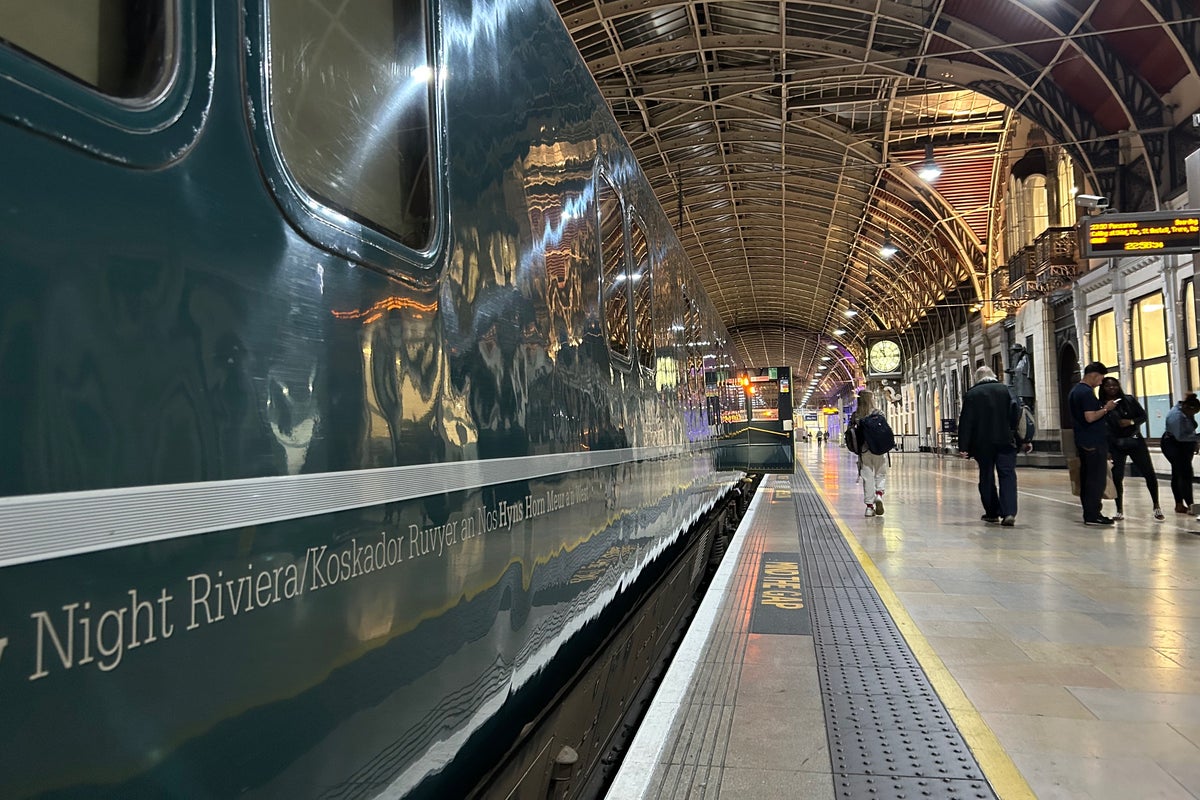The sleeper train holiday to Cornwall that doesn’t cost the Earth
With a £12,600 cabin price attached to Belmond’s luxury Britannic Explorer train service that launches from London to Cornwall later this month, Yvette Cook travels aboard GWR’s Night Riviera sleeper service in search of a holiday that makes a...

The knock grows louder, momentarily disorientating me from a deep sleep. It’s pitch black, the room sways, and a polite voice quietly shouts, “breakfast”. Opening the door, Nick, Great Western Railway’s hospitality manager, greets me with a smile and a tray crammed with pastries and coffee. Wobbling back to bed, I fumble around to open the blind and as it rattles up the window, a stream of golden sunlight rushes into my cabin. Squinting at the Cornish hills gliding by, I focus on nonchalant cows munching lush green grass and buttercups.
Eight hours before, I had boarded GWR’s Night Riviera sleeper train at London Paddington, beneath the gaze of its famous bear. Victorian arches glowed orange and the diesel engine hum created a nostalgic atmosphere until overexcited passengers bundled clumsily into their cabins. That liveliness extended into the restaurant car where a young family stocked up on biscuits, while retired Swedish women on holiday shared a table with young builders heading home. Over a nightcap, train enthusiast Howard Peach told me “there’s nothing quite like going to bed in one place, and waking in another”. As the train lurched out of the station, I tucked myself between a fluffy duvet and soft mattress, swaddling me into slumber. It hadn’t been a perfect sleep with squealing brakes and occasional bumps, yet each disturbance left me inquisitive about my location.

Read more: The best hotels in Cornwall 2025, reviewed
Now, the train slows, St Michael’s Mount rises out of the bay, and dog walkers fling tennis balls across the endless beach. As I cheerfully sip my black coffee, we halt in the seaside town of Penzance.
It’s ten years since I last drove to Cornwall, frustrated by the traffic I was contributing to. Overtourism has left litter on the beaches, butchers replaced by beachwear boutiques, and a lack of affordable housing caused by under-utilised holiday lets. It’s little wonder there is rising resentment toward tourists, yet 15 per cent of Cornwall’s economy is directly attributable to tourism. So, I’m here to understand how I can tweak my holiday so that my trip is both fun and supports local communities.
Starting at Penzance Bus Station, I hop aboard the 1A in search of top attractions and hidden coves. Only running every hour or two, it teaches me to slow down, although the driver counters this by careering down narrow lanes. Sycamore branches clonk windows and roadside foxgloves and ferns are sent into a dancing frenzy. My top-deck position provides far-reaching views of tin mine chimneys and pre-historic stone circles, scattered between villages and farms.
Within an hour, I reach Porthcurno village and walk smugly past the beach’s car park queue. At the Minack Theatre, I marvel at the ingenuity of its creator, Rowena Cade, who carved its terraces into granite cliffs. As the wind buffets tall blue echium flower stems in its sub-tropical garden, I wonder how tonight’s performance of Les Miserables will fare.

Read more: The best things to do in Cornwall, from surfing to seafood feasts
Instead of descending to Porthcurno’s crowded beach, I follow the South West Coastal Path curling around rugged cliffs, among a tapestry of wildflowers, including pompom-like pink thrift bobbing with the wind. The soundtrack of wrens and robins is interrupted by the laughter of three burly hikers with overgrown beards and oversized backpacks.
Only a fifteen-minute hike from Porthcurno and the panorama across the bay of Pedn Vounder feels otherworldly. Low cloud hangs over the craggy rock peninsula of Treryn Dinas that commands the crystal-clear, turquoise waters and golden sand banks. The final scramble down puts some off, meaning I am alone apart from a swimmer and a seagull with sights on my cheese sandwich. As the tide recedes, rock pools shrink and anemones retract their tentacles. My breathing slows to the rhythm of the waves and I catch myself nodding off. I jump up to take a ten-minute walk uphill to Treen village, replenishing calories with a cheeky hot chocolate at Fork + Fort, before catching the bus to Penzance Youth Hostel.
Walking along the babbling Larriggan River under a tunnel of maple trees, I’m greeted by a grand Georgian mansion. Small children run from the campsite into the ornate lounge to play Buckaroo, while a couple plan their hike on an oversized map. Having upgraded to a luxurious bell tent with cosy beds and a wood-burning stove, I make a well-earned cup of tea in the self-catering kitchen and sit outside listening to chiffchaffs.

Read more: The best bits of the South West Coast Path
After the check-in rush, Chris Nelson, the hostel’s manager, explains that “the joy of youth hostels comes from their special locations and multiple social spaces, where different groups can mix and children can wander freely”. Over the following days, I feel that community with families, couples, and solo travellers sharing food, stories from day trips, and advice on attractions, hiking trails, and the best fish and chips (Fraser’s on Penzance seafront, if you’re interested).
Given the Cornish housing crisis, staying in a holiday let was never an option, but I’m curious about the impact of my youth hostel stay. Chris proudly declares: “I employ all local people, we stock Cornish beers and we encourage guests to seek out independent cafes and businesses.”
I’m keen to do my bit and visit Truro’s bi-weekly farmers’ market to sample Cornwall’s finest foods. I’m pleasantly surprised to find a broad range; from locally-reared pork to cheeses, to wildflower honey and sea salt harvested on the Lizard peninsula. I relish listening to producers talk passionately about their food and its history.

Nick Dymond of St. Piran’s Pork and the Market’s Vice-Chair says: “A lot of food lovers stay in self-catering accommodation and the first thing they want to do is buy food, so this market is the obvious place.” Nick mentions that food tours and experiences are planned “so people can visit, select fresh meat and products, and have them cooked”. He tells me: “We see a large part of the market’s role as being educational for both tourists and locals.” But he adds that he wishes more tourists would travel mindfully and “not abandon their environmental mindsets on holiday”.
Read more: The best beaches in Cornwall
As I squeeze a wedge of Cornish Trelawny into my overladen bags, I ask the owner of Tin Coast Cheese, Debbie Shephard, what she thinks tourists could do to have a positive impact. She has one simple message: “Buy local.”
I live by these principles throughout my holiday, treating myself to tasty products from Penzance’s bakeries, groceries, and health food shops that line Causeway Head. Travelling by bus to St Michael’s Mount, Geevor Tin Mine, St. Ives, and Land’s End connects me with locals – many curious about my visit, but also eager to share how vital these services are for everyday life, from grocery trips to hospital appointments.

As I return to London, there is one final treat aboard GWR’s Pullman Dining Experience. Twice daily, a normal train carriage is transformed with white tablecloths, silverware, and attentive staff, serving freshly cooked meals including Oxfordshire fillet steak and Cornish Yarg cheese. As the train whizzes by people ambling on Dawlish beach, I celebrate my trip with a glass of Cornish Tarquin gin and tonic, reflecting how my choices to travel with impact have led to a more enjoyable and meaningful holiday. I’ve swapped Sainsbury’s Cheddar for Cornish Trelawny, a bland holiday rental for a Georgian mansion and friendly community, and – as the train runs alongside the M5 – a traffic jam for a magnificent fine-dining experience.
Getting there and back
GWR’s Night Riviera sleeper train service (gwr.com) runs six times a week between London Paddington and Penzance and takes around eight hours. Super off-peak return tickets cost £150 and a single cabin from £69. Accessible cabins are available too.
GWR’s Pullman Dining Experience is taken on either the 13:15 or 18:16 from Plymouth to Paddington and costs £38 for 2 courses and £46 for 3 courses. If you are travelling in standard class, speak to the restaurant manager when you board, if you’re in first class you can reserve up to an hour before departure.
Getting around
Transport for Cornwall’s website and app provide up-to-date information on timetables, fares and maps. A single ticket will cost no more than £3, unlimited journeys within Penzance cost £5.50 per day and within Cornwall £8 per day. Transportforcornwall.co.uk
Where to stay
Penzance Youth Hostel (yha.org.uk) has a range of accommodation including shared bedrooms (from £20 per night), private rooms (from £35 single, £45 double and £55 family rooms) and premium bell tents (from £100 per night).

 Tfoso
Tfoso 































